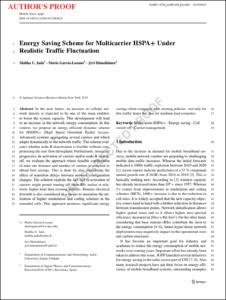Mostra el registre d'ítem simple
Energy saving scheme for multicarrier HSPA + under realistic traffic fluctuation
| dc.contributor.author | Jada, Maliha Urooj |
| dc.contributor.author | García Lozano, Mario |
| dc.contributor.author | Hämäläinen, Jyri |
| dc.contributor.other | Universitat Politècnica de Catalunya. Departament de Teoria del Senyal i Comunicacions |
| dc.date.accessioned | 2016-03-09T14:36:17Z |
| dc.date.available | 2016-10-03T00:30:23Z |
| dc.date.issued | 2016-04 |
| dc.identifier.citation | Jada, M. U., Garcia-Lozano, M., Hämäläinen, J. Energy saving scheme for multicarrier HSPA + under realistic traffic fluctuation. "Mobile networks and applications", Abril 2016, vol. 21, núm. 2, p. 247-258. |
| dc.identifier.issn | 1383-469X |
| dc.identifier.uri | http://hdl.handle.net/2117/84069 |
| dc.description | The final publication is available at Springer via http://dx.doi.org/10.1007/s11036-015-0656-6 |
| dc.description.abstract | In the near future, an increase in cellular network density is expected to be one of the main enablers to boost the system capacity. This development will lead to an increase in the network energy consumption. In this context, we propose an energy efficient dynamic scheme for HSDPA + (High Speed Downlink Packet Access-Advanced) systems aggregating several carriers and which adapts dynamically to the network traffic. The scheme evaluates whether node-B deactivation is feasible without compromising the user flow throughput. Furthermore, instead of progressive de-activation of carriers and/or node-B switch-off, we evaluate the approach where feasible combination of inter-site distance and number of carriers is searched to obtain best savings. This is done by also considering the effect of transition delays between network configuration changes. The solution exploits the fact that re-activation of carriers might permit turning off other BSs earlier at relatively higher load than existing policies. Remote electrical downtilt is also considered as a means to maximize the utilization of higher modulation and coding schemes in the extended cells. This approach promises significant energy savings when compared with existing policies - not only for low traffic hours but also for medium load scenarios. |
| dc.format.extent | 11 |
| dc.language.iso | eng |
| dc.subject | Àrees temàtiques de la UPC::Enginyeria de la telecomunicació::Radiocomunicació i exploració electromagnètica::Comunicacions mòbils |
| dc.subject.lcsh | Energy consumption |
| dc.subject.lcsh | Cell phone systems |
| dc.subject.other | Multicarrier HSPA + |
| dc.subject.other | Energy saving |
| dc.subject.other | Cell switch off |
| dc.subject.other | Carrier management |
| dc.title | Energy saving scheme for multicarrier HSPA + under realistic traffic fluctuation |
| dc.type | Article |
| dc.subject.lemac | Energia -- Consum |
| dc.subject.lemac | Telefonia mòbil |
| dc.contributor.group | Universitat Politècnica de Catalunya. WiComTec - Grup de recerca en Tecnologies i Comunicacions Sense Fils |
| dc.identifier.doi | 10.1007/s11036-015-0656-6 |
| dc.description.peerreviewed | Peer Reviewed |
| dc.relation.publisherversion | http://link.springer.com/article/10.1007/s11036-015-0656-6 |
| dc.rights.access | Open Access |
| local.identifier.drac | 17387428 |
| dc.description.version | Postprint (author's final draft) |
| local.citation.author | Jada, M. U.; Garcia-Lozano, M.; Hämäläinen, J. |
| local.citation.publicationName | Mobile networks and applications |
| local.citation.volume | 21 |
| local.citation.number | 2 |
| local.citation.startingPage | 247 |
| local.citation.endingPage | 258 |
Fitxers d'aquest items
Aquest ítem apareix a les col·leccions següents
-
Articles de revista [2.526]
-
Articles de revista [100]


